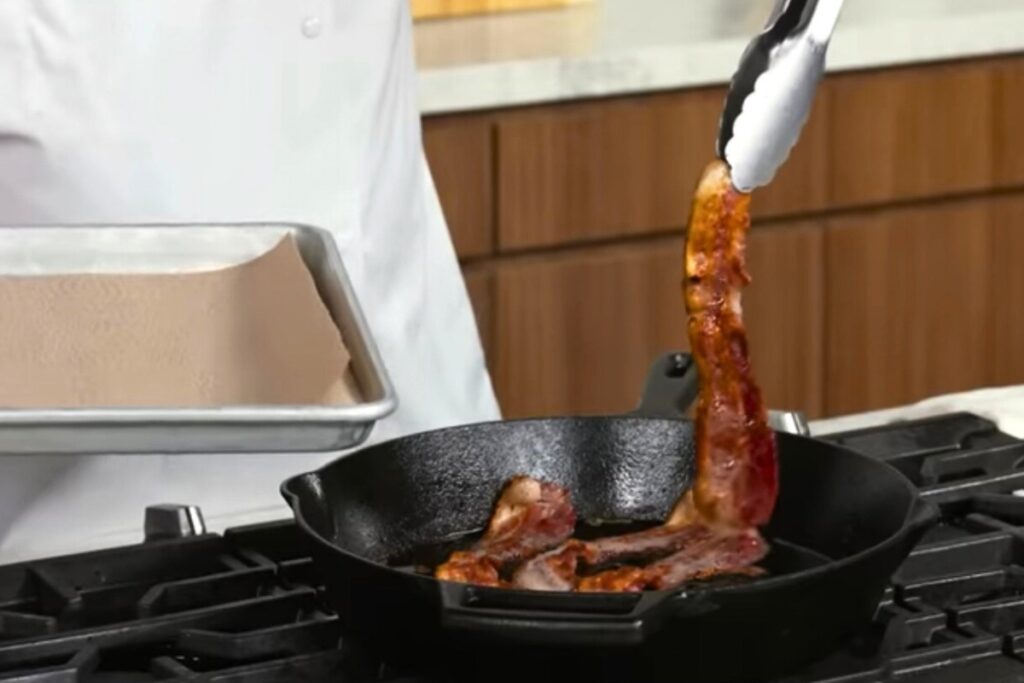Cooking bacon tends to be pretty easy and not all that time consuming. But everyone likes bacon done to their own specific standards- there’s no one ‘right way’ to know when your bacon is ready, aside from your own personal preference.
It can also be quite tricky to get your bacon just how you want it, even if you have a preference; the line between well done bacon and burnt bacon is rather thin. The following is a guide to knowing when every kind of bacon is ready, as well as everything else you need to know about cooking bacon.

How To Tell That Your Bacon Is Done
While there are a variety of types of bacon (and a variety of ways to cook it), there are a few things you should be looking out for when trying to tell if your bacon is ready, regardless of what type of bacon you’re cooking or how you’re cooking it. These include things like the texture of the bacon, its color, its shape, and its moisture content.
Texture
The most obvious tell that bacon is done is its texture. It can be quite hard to know what exactly you’re looking for, though. Because you can’t exactly use either your bite or your hands to check the bacon’s texture, you’ll have to rely on cutlery.
If you can break off a piece easily, then your bacon is probably done. The longer your bacon is cooking, the more frequently you should be checking its texture- you wouldn’t want to miss your moment to take it off the heat.
Color
Another way to tell how well done your bacon is is by its color. Most bacon, especially store bought bacon, is a light pink color with strips of white fat on the surface. Once it’s thoroughly cooked, it should have turned a golden brown color.
Once the bacon is brown, that’s when you should start checking the aforementioned texture. If the bacon goes a particularly dark brown, this probably means you’ve overcooked it.
Shape And Size
Bacon meat is initially quite thick, but throughout the cooking process, it will get gradually smaller- often by as much as 40%. This is because much of the bacon’s fat and moisture will evaporate when exposed to heat. If your bacon looks significantly smaller than it was when you started cooking, then it’s most likely almost done.
As for the shape of the bacon, it tends to be wavier around the edges when it’s nearly done, and its corners will curl upwards.
Moisture And Grease
Though during the cooking process your bacon will be soaked in an abundance of grease, once you’ve drained your bacon on paper towels all that should be left is dry, crisp slices.
The grease present while cooking is essentially the fat being evaporated. So, if you notice there’s very little grease remaining, your bacon is probably ready.

Ways To Cook Bacon
While thermometers designed for food do exist, in most cases they won’t help you when you’re cooking bacon. The most failsafe way to be sure that your bacon is done is by simply looking at it.
Obviously it’s very important that the meat has been cooked thoroughly enough, in order to kill off all the bacteria. There are some cases in which using a food thermometer will do the trick- mainly if the bacon you’re cooking is at least half an inch thick.
There are a few different ways to cook bacon, and the length it takes for your bacon to be ready varies depending on the method you’re using. The following is a quick guide to the different methods of cooking bacon, including how to know when your bacon is ready.
Cooking Bacon On The Stove
Once you’ve added all your bacon slices in a single layer on a cold skillet (ideally with tongs, just to be on the safe side), you should turn your stove to medium heat and use the tongs to turn over each slice roughly every minute. The timings may vary depending on your stove.
You should allow a minimum of eight to ten minutes for the bacon to cook. This might be longer, though, if your bacon slices are particularly thick. You should be looking for a brown color across the entire slice. When it comes to crispiness, it’s really just personal preference.
The final step that you might not have considered is putting the slices on paper towels. This will allow them to fully drain, and should take between 30 seconds to a minute.
Baking Bacon In The Oven
Put all your bacon slices in one layer on a rack in a baking dish (the shallower the better). You can also use a broiler pan, so long as you’re using tongs for the sake of safety. Preheat the oven to about 375 degrees Fahrenheit, and once it’s ready, insert your dish.
Regular cut bacon should be given at least 12 minutes to bake, and thick cut bacon requires at least 16 minutes. For bacon that’s extra thick (or a traditional butcher’s cut bacon), you should be allowing at least 19 minutes. You’ll know the bacon is done when it’s gone a brown color.
If you’re more into crispy bacon, you can give it another five minutes (and this is the case regardless of how thick the bacon is), but be aware that if you leave it any longer than this it might be crispier than is ideal.

Cooking Canadian Bacon
Aside from American style streaky bacon, another popular kind of bacon is the Canadian variant. Round slices made from pork loin, Canadian bacon is leaner than the bacon you might be used to, and cured and smoked in a way that makes it taste almost like ham.
There are a few differences when it comes to cooking Canadian bacon. For the first step, you’re going to want to heat olive oil on a skillet on your stove, at medium heat. Then, add your bacon slices to the skillet using tongs (or, if you have a roll of bacon rather than pre-cut slices, cut your slices depending on whichever thickness you prefer).
Cook the bacon for two minutes, and then turn it with your tongs and let it cook for another two minutes. Repeat this method until the bacon appears both brown and a little crispy.
This is one of the types of bacon where a food thermometer is actually useful (if it’s a fork style thermometer, anyway); if you own one (and if you’re sure it’s working properly), insert it a quarter of an inch into each slice of bacon that’s more than half an inch thick.
If the temperature is 160 degrees Fahrenheit, then it’s ready. Transfer the bacon slices to paper towels for draining, and then you can serve.
Cooking Bacon In A Smoker
While cooking bacon in a smoker takes a considerable amount of time, it’s also one of the easiest ways to cook this particular meat. Preheat your smoker to 300 degrees, and then add your bacon onto the grate.
You’re going to want to put something under the grate in order to catch drippings- cleaning up grease in a smoker isn’t something anybody wants to have to deal with. The bacon should take about 30 minutes, but you should be checking it often to avoid overcooking.
Different Types Of Bacon
If you’re in America you’re probably most familiar with streaky bacon, which is made from pork belly, cured in salt and spices, and smoked, but you’d be surprised just how many different types of bacon there are.
Lardons
Cuts of pork belly or loin that have been cured in salt and seasonings, lardons are cut into either cubes or matchstick shapes. Lardons are most often present in recipes that require a bacon flavor but not entire slices, like roasts, sauces, or salads.
Rashers (English Or Irish Bacon)
Similar to Canadian bacon, rashers are another type of back bacon. The difference here is that they have a layer of fat around the edges.

Pancetta
If you’re familiar with pancetta, it might not have even occured to you that it’s a kind of bacon. It originated in Italy, and its thin slices show a sort of spiral of meat and fat.
Made from pork belly, Pancetta is cured with various spices, including clove, juniper, or rosemary, and it tends not to be smoked. Its flavor is a lot more subtle than other kinds of bacon.
Szalonna
Often referred to as Hungarian bacon, the flavor of this type is spicier than other types, which is due to the garlic and paprika that’s rubbed into this cured and smoked back bacon. Szalonna tends to be either sliced or cubed and skewered on sticks, and is usually roasted over a campfire.
Guanciale
Another Italian bacon, this particular type is made from the pork jowl. It tends not to be smoked, and its curing time and drying time are longer than those of other types of bacon.
With a flavor stronger than the aforementioned pancetta, this bacon is both soft and fatty, and can often be found in Italian sauces like carbonara.
Peameal Bacon
It might seem a bit out there for those outside of Canada, but in Toronto this traditional kind of bacon is quite popular.
Much like ordinary Canadian bacon, it’s made from pork loin, but what makes this kind unique is that it’s first wet-cured in salty brine before then being rolled in dried, crushed yellow peas- although while the peas are still used fairly regularly, it’s more commonly cornmeal these days.
Speck
Speck is made from the hind leg of the pork, which is the same cut that’s used for ham. The spice blend used for curing speck is what makes it so unique, which usually includes crushed juniper berries.
Cottage Bacon (Buckboard Bacon)
While cottage bacon is both cured and smoked like ordinary bacon, it’s made from pork shoulder, which results in a meatier slice than bacon that’s made from pork belly.

Can You Cook Bacon In The Microwave?
It is actually possible to cook bacon in the microwave, but if your preferred bacon is crispy, it’s probably not worth bothering.
It’s certainly the quickest way to cook bacon, though. All you’ll need to do is place two or three paper towels inside a microwave-safe dish, before placing the bacon in a single layer on top. Then, place either one or two paper towels on top of the bacon, and microwave at a high temperature for roughly one minute per slice.
Once it’s done, leave it to stand for a minute before serving. The upside to cooking bacon in the microwave, as sacrilegious as it may seem, is that you can quickly and easily cook multiple strips of bacon at once. There’s also, naturally, a lot less cleanup required.
But, as we said, it’s going to be more chewy than it is crisp. So if that’s not to your tastes, steer clear, and stick with one of the more traditional methods.
Final Thoughts: How To Tell When Bacon Is Done
While there are a variety of ways to cook bacon, and a variety of types of bacon to cook, the process of knowing when your bacon is done is quite straightforward. As long as you keep an eye on the texture, color, shape & size, and moisture content, you should be able to master the process of cooking bacon in a couple of tries.
- Is Blue Steak Safe To Eat? - May 7, 2022
- How To Tell If Your Bratwurst Sausage Is Cooked - May 7, 2022
- The Internal Temperature For Tri Tip When Done - May 7, 2022








